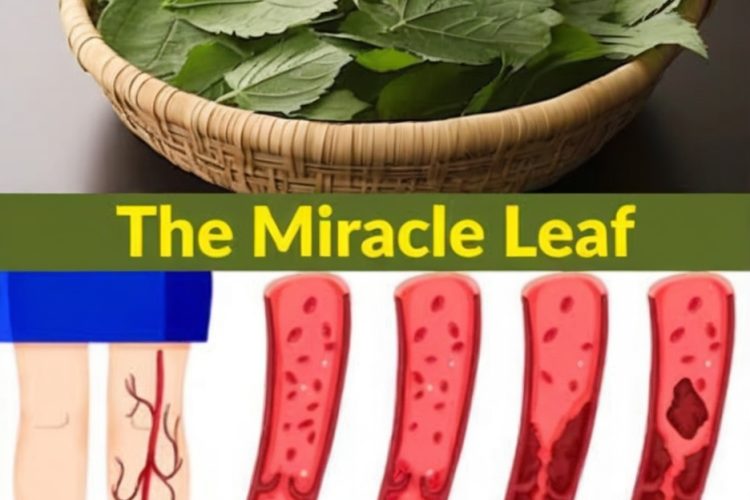WANT TO SAVE THIS RECIPE ?
7 Healing Leaves for Diabetes, Blood Pressure, Pain Relief, Cholesterol, and Circulation
Nature offers a range of powerful, healing leaves that can naturally support vital health concerns, including diabetes management, blood pressure control, pain relief, cholesterol reduction, and improved circulation. Here’s a guide to seven potent leaves, their key benefits, and how to use them effectively.
1. Moringa Leaves (Moringa oleifera)
Benefits:
-
Lowers blood sugar levels
-
Reduces blood pressure
-
Provides anti-inflammatory effects
-
Supports cholesterol management
How to Use:
-
Tea: Steep 1 teaspoon of dried moringa leaves in hot water for 5–10 minutes. Drink once daily.
-
Powder: Add moringa powder to smoothies or sprinkle it over salads.
Helpful Tip: Moringa powder can be a convenient way to enjoy the benefits of this nutrient-dense leaf.
2. Blackberry Leaves (Rubus fruticosus)
Benefits:
-
Regulates blood sugar
-
Supports cardiovascular health
-
Reduces inflammation
-
Promotes healthy blood circulation
How to Use:
-
Tea: Steep 1 tablespoon of dried blackberry leaves in boiling water for 10 minutes. Strain and drink once daily.
Helpful Tip: Use properly dried leaves to avoid bitterness and maximize antioxidant content.
3. Olive Leaves (Olea europaea)
Benefits:
-
Naturally lowers blood pressure
-
Reduces LDL cholesterol levels
-
Strengthens the cardiovascular system
How to Use:
-
Tea: Steep 1 teaspoon of dried olive leaves in a cup of hot water for 10 minutes. Drink once daily.
-
Supplement: Olive leaf extract is available in capsule or liquid form for easy dosing.
Helpful Tip: Olive leaf extract is particularly effective in managing hypertension, as supported by clinical studies.
4. Cashew Leaves (Anacardium occidentale)
Benefits:
-
Controls blood sugar levels
-
Reduces blood pressure
-
Combats inflammation and joint pain
How to Use:
-
Chewing: Chew a few fresh cashew leaves for blood sugar support.
-
Infusion: Steep a handful of fresh or dried leaves in hot water for 10 minutes. Drink 1–2 times daily.
Helpful Tip: Avoid overconsumption, especially if you have a nut allergy.
5. Mint Leaves (Mentha spp.) 🍃
Benefits:
-
Improves blood circulation
-
Relieves muscle and joint pain
-
Calms digestive discomfort
How to Use:
-
Tea: Steep fresh mint leaves in boiling water for 5–7 minutes.
-
Compress: Apply a warm mint compress to sore areas to alleviate pain.
Helpful Tip: Peppermint oil can be diluted and used for massages to relieve muscle tension.
6. Horsetail Leaves (Equisetum arvense)
Benefits:
-
Boosts circulation
-
Acts as a natural diuretic
-
Reduces water retention, aiding blood pressure control
How to Use:
-
Tea: Brew 1 tablespoon of dried horsetail leaves in a cup of boiling water. Drink occasionally, not daily.
Helpful Tip: Horsetail is a natural diuretic; avoid excessive use to prevent nutrient loss.
7. Rosemary Leaves (Rosmarinus officinalis)
Benefits:
-
Stimulates blood circulation
-
Reduces muscular pain and headaches
-
Regulates blood pressure naturally
How to Use:
-
Tea: Steep fresh rosemary leaves in hot water for 10 minutes.
-
Massage Oil: Infuse rosemary in carrier oil and massage onto sore muscles.
Helpful Tip: Inhaling rosemary steam can also improve respiratory function and circulation.
Usage and Safety Considerations:
-
Dosage: Start with small amounts to monitor how your body reacts.
-
Consultation: Always consult with a healthcare provider, especially if you are on medications for blood pressure, diabetes, or heart conditions.
-
Storage: Store dried leaves in a cool, dark place to preserve potency.
-
Caution: Avoid combining diuretic leaves (like horsetail) with prescribed diuretic medications to prevent excessive fluid loss.
Final Thoughts:
Incorporating these healing leaves into your routine can provide natural support for various health conditions, including diabetes, blood pressure, pain relief, and circulation. Whether you prefer teas, infusions, or topical applications, these potent plants offer a range of health-promoting benefits. Always use them mindfully, starting with small doses and consulting with your healthcare provider for guidance.
